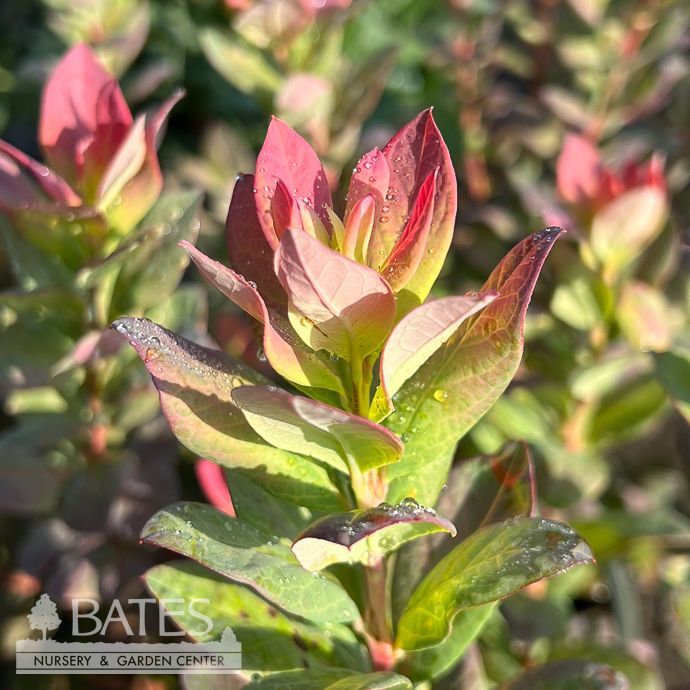Edible #2 Vaccinium cory Bountiful Belle/ Northern Highbush Blueberry Native (TN)
Edible #2 Vaccinium cory Bountiful Belle/ Northern Highbush Blueberry Native (TN)
SCIENTIFIC NAME: Vaccinium corymbosum hybrid 'FC10-076' PPAF
COMMON NAME: Bountiful Belle Northern Highbush Blueberry
GARDEN SIZE: 3-4 feet tall x 3-4 feet wide
GROWTH RATE: Reaches maturity in 6-8 years
USDA ZONE: 5-9
CHILL HOURS: 800 (Possibly fewer - this new cultivar is still being tested.)
EXPOSURE: Full Sun
WATER & SOIL: Acidic, well-drained soil high in organic matter
HABIT (FORM): Compact, multi-stemmed woody shrub
FOLIAGE: Deciduous with silvery-pink new growth and blue-green mature leaves. Foliage turns red-orange in autumn.
FLOWERS: Clusters of small, bell-shaped, pink and white flowers
BLOOM TIME: Early spring
HARVEST TIME: Early to mid summer
POLLENIZATION: Northern highbush blueberries (Vaccinium corymbosum) are self-fertile and produce some fruit in isolation, but they yield a bigger crop of larger berries with a compatible partner nearby. Plant near a highbush blueberry of a different variety that blooms around the same time to enable cross-pollenization.
POLLENIZATION PARTNERS: Recommended partners for Bountiful Belle include later-blooming highbush cultivars such as Blue Ribbon, Bluecrop, Blueray, Bountiful Baby, Mini Blues, Sky Dew Gold, Sweetheart, and Top Shelf.
FRUIT: Medium-sized, dark blue berries with a sweet flavor and soft texture
CARE: When planting, condition the soil in an area twice the diameter of the root ball with peat moss or a soil conditioner like our Earthmix Landscape. Mix soil conditioner with existing soil in a 50/50 ratio.
Mulch with 2-6 inches of straw, wood chips, or other organic matter to help regulate moisture. Leave a gap of a few inches around the trunks to prevent damage to the stems from staying wet.
Blueberry bushes need about an inch of water every 7-10 days, though young bushes need a little more during their first growing season while they establish roots. If not enough rain has fallen, give a deep soak to the soil around the base of the plant once or twice per week. A good rule of thumb is 1 gallon of water per square foot of surface area under the canopy.
Fertilize each spring and fall with Holly-tone or another fertilizer made for acid-loving plants.
Prune in late winter to early spring while the plant is dormant. Remove weak canes and low-growing shoots that will be shaded by other limbs or touch the ground. If desired, cut taller canes down to within arm's reach to make it easier to harvest berries.
When your blueberry bush is about five years old, you may notice older canes becoming less productive. At this stage, begin cutting back 20% of the thick, gray, older branches to ground level each year. This will allow the canes to completely refresh themselves in a five year cycle.
PET SAFETY: May cause gastrointestinal issues in cats and dogs if consumed in large amounts, but not commonly eaten by pets. Always research further if you have concerns, as reactions can occur with anything. Also, remember to check the safety of any fertilizers or pesticides applied to your plants.
USES: Edible berries, decorative foliage, container planting, hedges, borders, fall color
HISTORY: The Bountiful Belle blueberry was first bred in Lowell, Oregon in 2008. It comes from the cross of two unpatented highbush blueberries as part of a controlled breeding program. In a patent application for the cultivar, Oregon blueberry breeders Adam Wagner and Peter Stefan Boches are credited as the cultivar's inventors. The Conard-Pyle company applied for this patent in 2023, and as of August 2025, it is currently awaiting approval.
In the meantime, Bountiful Belle is marketed by Monrovia as part of its Bountiful Blueberries series, alongside Bountiful Baby, Bountiful Blue, and Bountiful Delight.
Data is a little sparse on this new blueberry. More information should become available in the coming years as gardeners try it out in all kinds of climates and conditions.

